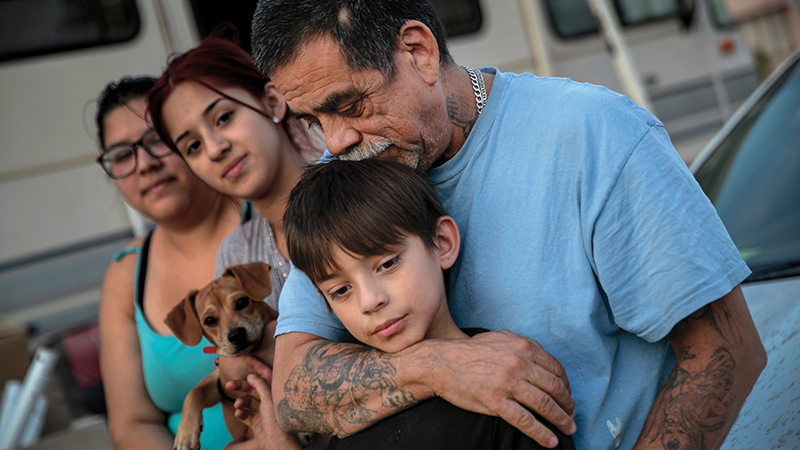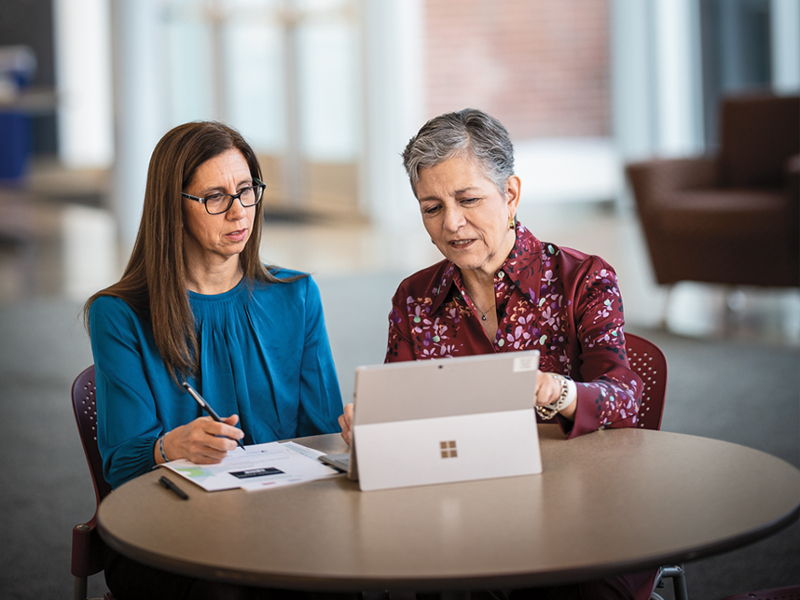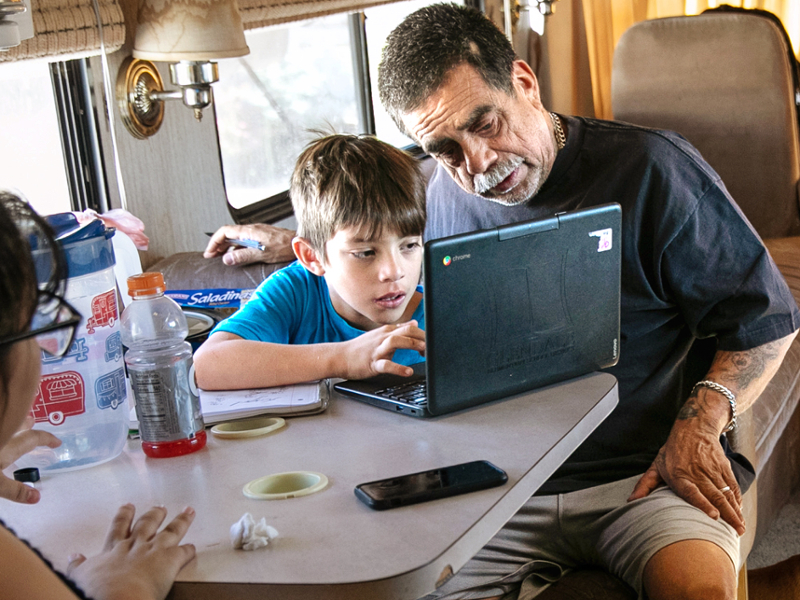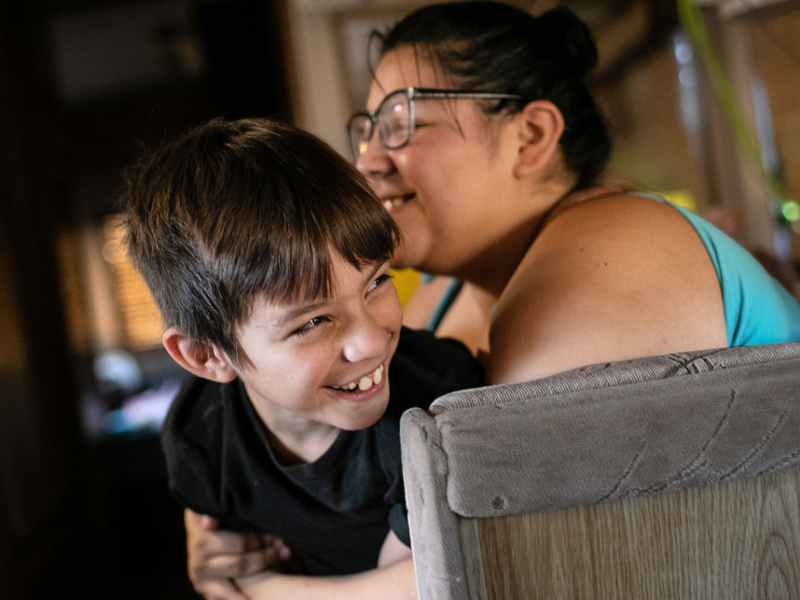
By Leah Shafer, MPP/MBA’20
You may have seen the headlines — the United States experienced a sharp drop in child poverty rates over the past three decades, due in large part to expansions in the social safety net.
But for the millions of children still living in poverty, we haven’t gone far enough. The U.S. has higher child poverty rates than most other industrialized nations, despite being one of the richest countries in the world.
And for researchers at the Institute for Child, Youth, and Family Policy (ICYFP), this challenge is inextricably linked to racial and ethnic equity. According to the U.S. Census Bureau, in 2020, our child poverty rate was 9.7%, or 7.2 million children growing up without the basic resources needed for healthy child development and future success — and more than 60% are Hispanic or Black.
That injustice drives the work of ICYFP. “Racial and ethnic inequities in children’s opportunities and well-being are our focus,” says Dolores Acevedo-Garcia, ICYFP’s director and the Samuel F. and Rose B. Gingold Professor of Human Development and Social Policy. “We ask: How can we reduce poverty, and how can we reduce poverty for the most vulnerable children?”
A remarkable opportunity
Five years ago, Acevedo-Garcia brought ICYFP’s expertise and perspective to a unique and historic gathering. The National Academies of Sciences, Engineering, and Medicine (NASEM) called together a committee of experts to explore the effects of child poverty in the United States, and evaluate and recommend solutions to cut child poverty in half within 10 years. The committee was congressionally mandated, with federal funding and sponsorship from Reps. Barbara Lee (D-Calif.) and Lucille Roybal-Allard (D-Calif.). NASEM asked Acevedo-Garcia to be a member of the group.

“We were intent on bringing a focus on equity to that work,” says Acevedo-Garcia, noting that the basic story of child poverty in the U.S. is one of racial and ethnic inequity. According to the U.S. Census, Black and Hispanic children are about three times as likely to grow up in poverty as white children, a gap that has actually widened over the past decade, even as overall child poverty has declined. But too often, a racial/ethnic outlook gets lost in such a large and thorny issue.
“A Roadmap to Reducing Child Poverty,” the committee’s conclusive report, published in 2019, made clear that for anti-poverty policy to be fully effective, it must include the highest-need children. And while NASEM has a long history of connecting research to policy, this report has been particularly consequential. In her 2021 presidential address, NASEM President Marcia McNutt said, “The [Roadmap] report provided the evidence foundation for the $3,000 child allowance in the American Rescue Plan of 2021.”
Getting the word out
For ICYFP, the publication of “A Roadmap to Reducing Child Poverty” was only the beginning. In the months that followed, Acevedo-Garcia and Pamela Joshi, PhD’01, senior scientist and policy research director at ICYFP’s project diversitydatakids.org, helped ensure that researchers and policymakers continued the conversation. In November 2019, Acevedo-Garcia and Joshi, in partnership with NASEM, led a meeting among policy experts on the racial/ethnic equity aspects of the report. Meeting inside the Federal Reserve Bank of Boston, panelists from think tanks and universities across the country discussed persistent inequities in anti-poverty policy and how to ensure that eligibility and implementation did not disproportionately harm Black, Hispanic, and immigrant families.
ICYFP continued to push for policy changes that would target racial gaps. In 2020, Rep. Rosa DeLauro (D-Conn.) led a hearing for the House Appropriations Committee on the “Roadmap” findings and asked Acevedo-Garcia to testify. “Child poverty is not an intractable problem,” Acevedo-Garcia explained then. But, she continued, “An important policy and research question is whether we can design and implement effective social policy if we ignore these wide racial and ethnic inequities in child poverty. My opinion is that we will achieve the goal of poverty reduction faster if we are more intentional about policy design so that the benefits of anti-poverty programs include all children, and programs help us reduce inequities in poverty.”
The equity analysis work continues
Beyond public engagement, ICYFP scholars are committed to continuing the equity analyses that informed the “Roadmap” report. An opportunity came their way in early 2020, when UnidosUS, the nation’s largest Latino civil rights and advocacy organization, reached out. They proposed partnering with the ICYFP team to investigate how restrictions in the social safety net had affected children in immigrant families.
A number of policy and economic changes in the past several decades have made children in immigrant families one of the nation’s most vulnerable groups. These children, 72% of whom are Hispanic, are twice as likely to live in poverty as those with U.S.-born parents. Citizen children with undocumented family members — who make up 18% of children in poverty — are largely excluded from the social safety net. In 2020, they were ineligible for the first round of stimulus payments, even though their parents were disproportionately frontline workers experiencing the worst of the economic and health impacts from the pandemic.

Together with UnidosUS, Acevedo-Garcia, Joshi, and research associate Abigail Walters began a series of projects researching the inequities immigrant families face and what reforms would help. They commissioned the Urban Institute to use TRIM3 — the poverty simulation model employed for the NASEM report — to produce new poverty-rate estimates for children in immigrant families and the effects of including these children in safety net programs. With those estimates in hand, ICYFP and UnidosUS published two papers in the journals Health Affairs and Academic Pediatrics. These papers analyzed how policies like the Earned Income Tax Credit (EITC) and the Supplemental Nutrition Assistance Program (SNAP) restrict access to children in immigrant families, the long-term health effects of those exclusions — and how to revise the safety net to be more inclusive.
To continue engaging policymakers, the groups hosted a workshop with NASEM on how to promote the health and well-being of children in immigrant families in pandemic recovery efforts. They also co-hosted a briefing for Capitol Hill lawmakers to share how the American Rescue Plan had made progress in supporting Hispanic children, and discuss what policy change was still needed.
“Our work with UnidosUS and the Urban Institute has allowed us to deepen our policy equity analyses and connect that research to changemakers,” says Joshi.
She continues, “UnidosUS has helped us identify moments of opportunity for advocates and legislators, and we have been able to provide them with data and analysis that show where policies have fallen short and which racially equitable solutions could fix them.”
Fighting child poverty by boosting family economic security
Throughout this time, ICYFP has continued its long-standing work on a second, fundamental part of the child poverty puzzle. “The poverty line is such a low benchmark, so we are trying to broaden the conversation from child poverty to child opportunity and family economic security,” says Joshi. “The next step in the conversation is: What do children and families really need to have an economically secure childhood and thrive?”
The answer goes beyond anti-poverty programs. ICYFP has researched differences in family job quality for over a decade. This past summer, the institute’s paper in RSF: The Russell Sage Foundation Journal of the Social Sciences reported that, in the years leading up to the pandemic, one-third of families — and more than half of Black and Hispanic families — working full time did not earn enough to cover basic expenses.
The researchers found inequitable access to policies that are meant to support working families, too. For example, using the peer-reviewed Policy Equity Assessment framework — a method to analyze whether social policies reduce or exacerbate racial inequities — ICYFP has shown that the Family and Medical Leave Act (FMLA) is largely only accessible to higher-income working parents, who are more likely to be white. Many working families cannot afford to take the unpaid leave that FMLA grants. Those who do are more likely to fall into financial hardship, which exacerbates racial and ethnic inequities; one in four (26%) of Black and Hispanic families who take six weeks of unpaid leave would fall into the category of “low-income,” as opposed to only 15% of white families.
A larger network is taking up the cause
These issues are gaining traction. “We are part of a network of foundations, programs, researchers, and advocates supporting this work,” says Acevedo-Garcia. As proposals to establish a national paid family-leave program entered the mainstream, ICYFP’s equity-focused FMLA analyses found a foothold. The work has been cited several times by advocates that include the National Partnership for Women and Families and the Leadership Conference on Civil and Human Rights.

ICYFP’s work on children in immigrant families has begun reaching new policy audiences, too. After releasing a report in April 2022 on inequities in EITC eligibility, Acevedo-Garcia and Joshi spoke to a series of coalitions on how to make the policy more inclusive of children in immigrant families. These audiences included advocates focused on expanding state-level tax credits — policy changes that are incremental but feasible in the short-term, and still impactful.
Funders have also become explicit champions of this work. Last winter, as the expanded Child Tax Credit was expiring, Acevedo-Garcia co-authored an op-ed in The Hill with Robert Wood Johnson Foundation (RWJF) President and CEO Richard Besser on the importance of making the policy permanent and even more expansive in order to strengthen child outcomes. The W.K. Kellogg Foundation, which helped fund the original NASEM report, is now supporting two new NASEM committees focused on reducing intergenerational poverty and on understanding child opportunity gaps (Joshi is a member of the latter).
Over the past year, Acevedo-Garcia and Joshi have had the chance to bring their expertise in racial equity analysis to a new level. Serving as senior advisers in the U.S. Department of Health and Human Services (HHS) Office of the Assistant Secretary for Planning and Evaluation (ASPE), they are building staff capacity to analyze racial/ethnic inequities and identify policy levers to improve equity within human services programs and practices. Says Joshi, “This has been an incredible opportunity to share frameworks with top decision-makers, and we’ve gained important insights into how federal-level conversations around racial equity actually take shape.”
Some good news for the long road ahead
This past fall, the fight against child poverty received some good news. A report from the research organization Child Trends found that the child poverty rate declined by more than half from 1993 to 2019, and statistics released by the U.S. Census Bureau showed that, in 2021, child poverty fell to 5.2% — its lowest rate on record. Both reports made clear that the social safety net — namely, tax credits and SNAP over the past 30 years, and the expanded Child Tax Credit in 2021 — played a significant role in keeping children out of poverty.
Acevedo-Garcia, who reviewed the Child Trends report before publication and was interviewed by The New York Times at its release, has remarked on the significance of these findings. Large racial/ethnic inequities remain in child poverty, and the failure to make the expanded Child Tax Credit permanent in 2022 have left many discouraged. But these data show that they know what works.
“As an academic, you always fear that rigorous evidence won’t lead to the kind of changes we need,” says Acevedo-Garcia. “But we showed in the pandemic that being more inclusive of the children who are usually excluded from safety-net policy is possible.”
Now, she says, “We are focused on continuing to assemble the evidence that expanding these safety net policies to include more children would have an enormously beneficial effect. We have been working on improving racial and ethnic equity for decades, and we believe this lens is essential in the fight against child poverty.” For ICYFP, “We are in this for the long haul.”
